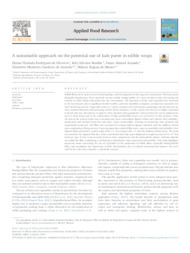A sustainable approach on the potential use of kale puree in edible wraps.
A sustainable approach on the potential use of kale puree in edible wraps.
Author(s): OLIVEIRA, E. F. R. de; BONFIM, K. S.; AOUADA, F. A.; AZEREDO, H. M. C. de; MOURA, M. R. de
Summary: Edible films can be used to prevent food spoilage, and investigations in this regard are paramount. When prepared alongside biopolymers, these materials become totally biodegradable in a short period of time, decreasing the amount of solid residues discarded into the environment. The ingestion of fruits and vegetables has increased in the last decades due to significant health benefits, and their durability comprises an important parameter for their marketing and use. Vegetables come in a variety of colors, sizes and shapes, comprising relevant features for their commercialization and packaging and for final consumers. In this regard, kale leaves are highly consumed in Brazil and new alternatives to improve their physical and organoleptic characteristics for novel applications, such as food wraps and in the replacement of high perishability leaves, are of interest in this scenario. Thus, the aim of the present study was to develop kale puree and sodium alginate films and evaluate their solubility, mechanical and thermal properties and water vapor permeability, focusing on improving their physical and organoleptic properties. The films were prepared by casting sodium alginate solutions with the addition of kale puree employing a film generator. Puree incorporation reduced film water vapor permeability and solubility. Pure alginate films presented a contact angle of 50 ± 1°, increasing to 62 ± 2° with the addition of kale puree. The same was noted for the alginate film that, when cross-linked with kale puree displayed an angle increase of 72 ± 5° This behavior may be due to interactions between these components and the hydrophobic phases. Calcium chloride was added for film crosslinking, contributing to biopolymer chain separation and mobility. This study highlights important issues concerning the use of vegetables in the production of edible films, especially biodegradable films, and emphasizes the importance of their development, due to reduced environmental impacts, low costs and the fact that they comprise a renewable resource.
Publication year: 2023
Types of publication: Journal article
Unit: Embrapa Instrumentation
Observation
Some of Embrapa's publications are published as ePub files. To read them, use or download one of the following free software options to your computer or mobile device. Android: Google Play Books; IOS: iBooks; Windows and Linux: Calibre.
Access other publications
Access the Agricultural Research Database (BDPA) to consult Embrapa's full library collection and records.
Visit Embrapa Bookstore to purchase books and other publications sold by Embrapa.

